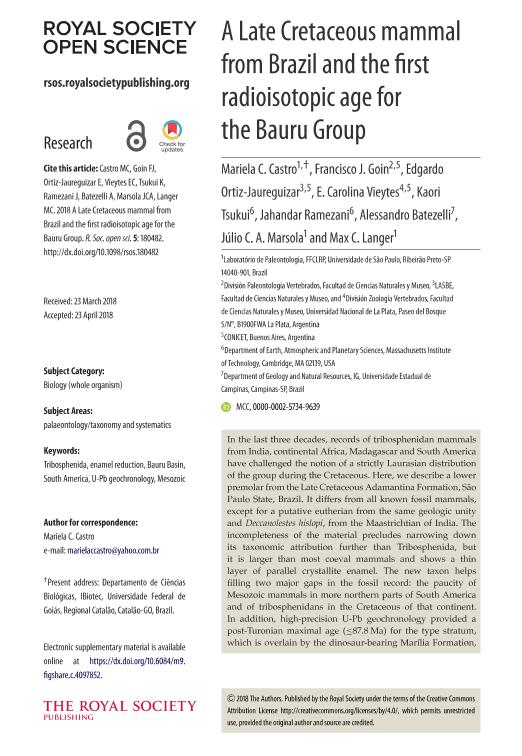Artículo
A Late Cretaceous mammal from Brazil and the first radioisotopic age for the Bauru Group
Castro, Mariela; Goin, Francisco Javier ; Ortiz Jaureguizar, Edgardo
; Ortiz Jaureguizar, Edgardo ; Vieytes, Emma Carolina
; Vieytes, Emma Carolina ; Tsukui, Kaori; Ramezani, Jahandar; Batezelli, Alessandro; Marsola, Julio; Langer, Max
; Tsukui, Kaori; Ramezani, Jahandar; Batezelli, Alessandro; Marsola, Julio; Langer, Max
 ; Ortiz Jaureguizar, Edgardo
; Ortiz Jaureguizar, Edgardo ; Vieytes, Emma Carolina
; Vieytes, Emma Carolina ; Tsukui, Kaori; Ramezani, Jahandar; Batezelli, Alessandro; Marsola, Julio; Langer, Max
; Tsukui, Kaori; Ramezani, Jahandar; Batezelli, Alessandro; Marsola, Julio; Langer, Max
Fecha de publicación:
04/2018
Editorial:
The Royal Society
Revista:
Royal Society Open Science
ISSN:
2054-5703
Idioma:
Inglés
Tipo de recurso:
Artículo publicado
Clasificación temática:
Resumen
In the last three decades, records of tribosphenidan mammals from India, continental Africa, Madagascar and South America have challenged the notion of a strictly Laurasian distribution of the group during the Cretaceous. Here, we describe a lower premolar from the Late Cretaceous Adamantina Formation, SãoPaulo State, Brazil. It differs from all known fossil mammals, except for a putative eutherian from the same geologic unity and Deccanolestes hislopi, from the Maastrichtian of India. The incompleteness of the material precludes narrowing down its taxonomic attribution further than Tribosphenida, butit is larger than most coeval mammals and shows a thin layer of parallel crystallite enamel. The new taxon helps filling two major gaps in the fossil record: the paucity of Mesozoic mammals in more northern parts of South Americaand of tribosphenidans in the Cretaceous of that continent. In addition, high-precision U-Pb geochronology provided a post-Turonian maximal age (≤87.8 Ma) for the type stratum, which is overlain by the dinosaur-bearing Marília Formation, constraining the age of the Adamantina Formation at the site to late Coniacian?late Maastrichtian. This represents the first radioisotopic age for the Bauru Group, a key stratigraphic unit for the study of Cretaceous tetrapods in Gondwana.
Palabras clave:
MAMMAL
,
LATE CRETACEOUS
,
BRASIL
,
BAURU GROUP
Archivos asociados
Licencia
Identificadores
Colecciones
Articulos(CCT - LA PLATA)
Articulos de CTRO.CIENTIFICO TECNOL.CONICET - LA PLATA
Articulos de CTRO.CIENTIFICO TECNOL.CONICET - LA PLATA
Citación
Castro, Mariela; Goin, Francisco Javier; Ortiz Jaureguizar, Edgardo; Vieytes, Emma Carolina; Tsukui, Kaori; et al.; A Late Cretaceous mammal from Brazil and the first radioisotopic age for the Bauru Group; The Royal Society; Royal Society Open Science; 5; 5; 4-2018; 1-11
Compartir
Altmétricas



